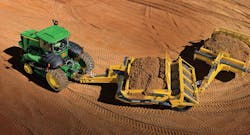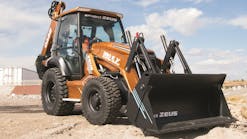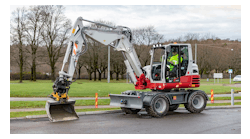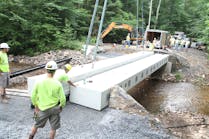“A trailer is a trailer is a trailer,” opines Mike Ross, director of engineering for Towmaster.
“You hook it on to the end of the truck, put stuff on it, and pull it down the road. There’s nothing new until we design one without wheels. There’s nothing innovative; the trailer is unchanged in 20 to 30 years.”
He’s right. They made be different lengths, different widths, made of different materials and mounted on one or more axles, but trailers are all basically the same. Or are they?
Customization
What’s changed, contends Ross, is the way we’re using them. “People used to figure out how to use a trailer the way it was built or they made their own modifications. Now, they ask for modifications up front because they don’t want to fix a brand-new trailer.” Conveniences are being added at the factory today.
He says Towmaster Inc.’s willingness to work one-on-one with each customer to create the right trailer for them has kept the Minnesota-based company in business since 1979.
The reason custom trailers are so popular is that what each hauler wants is different—and what each hauler wants can vary day by day, depending on the job. “There’s no one answer,” says Ross. “There’s such a wide variety of contractors and what they haul. That’s why we customize extensively.”
Ross remembers one Towmaster customer who wanted a trailer for concrete work. “They needed propane-fired heaters to thaw the ground, so we designed a trailer with an integral rack to store, secure, and lock the heaters.” When spring arrives, he says the rack can be unbolted so the customer can put a Bobcat on the trailer in its place.
XL Specialized also customizes to meet the customer’s needs, says Rodney Crim, vice president of sales. “We custom-build a lot for equipment. We’ve built trailers with interchangeable decks, trailers that feature a beam deck for dozers, drop-side trailers for cranes, and trailers with a flat deck for loading a group of skid-steers.” Placement of tie-down points and lighting plugs can be customized for various types of loads.
“Every trailer is different,” continues Crim. But they all start as a base model. “Then we create a custom machine.”
Legal Limits
Although every manufacturer strives to please each customer, Ross confesses that sometimes Towmaster has to say no. “We have to abide by DOT rules. We still have to conform to the laws,” he explains. “For instance, you can’t haul three pieces of equipment legally.”
Everyone in the industry is aware of the Federal Bridge Gross Weight Formula: bridge laws. It’s a mathematical formula the DOT uses to determine the appropriate maximum gross weight of commercial motor vehicles, based on the number and spacing of axles. Part of the federal weight and size regulations of interstate commercial traffic, the formula’s purpose is to prevent heavy vehicles from damaging roads and bridges.
The first weight limits were enacted in 1913 by four states, with the intention of protecting gravel roads from damage by the solid rubber wheels used on heavy trucks. Within 20 years, every state had some type of weight regulation.
The Federal Aid Highway Act of 1956 established uniform federal regulations, but after a series of field tests to determine the impact of traffic on roads and bridges, conducted by the American Association of State Highway and Transportation Officials, a formula was established to replace a single gross weight limit. That formula became law in the Federal Aid Highway Act Amendments of 1974, which also established a gross weight limit.
The intention is to prevent the concentrated weight on a truck’s axle from producing stress on bridge components that might lead to a collapse. Distributing weight through a proscribed weight-to-length ratio minimizes impact on bridge members. For heavy trucks to comply with the formula, they must add axles or increase the distance between the axles.
As complicated as the formula may be, enforcement can be even trickier. The Federal Motor Carrier Safety Administration, a division of the DOT, enforces the length, width, and weight limits set by the Federal Highway Administration for interstate commercial traffic. If a truck remains on interstates, US highways, and state highways, it is not subject to state limits. However, there are also limits for intrastate commercial traffic that can be lower or higher than federal limits.
“Most states are close to federal standards,” believes Ross, “but standards change, and it depends on the state. California laws are very different; everyone gets stopped. There are fewer bridges in some states, so their rules might be different.” He says it’s difficult to make sure they’re maintaining proper tire ratings and wheel base length, especially with contractors who run in Minnesota during the summer and in Arizona during the winter.
An XL Specialized trailer carrying a Caterpillar dozer
Fortunately, the specialized heavy haulers know the law, observes Ross. They usually know what they want in a trailer, too.
The trained sales force at XL Specialized knows the weight distribution in each state, says Crim, and are able to help with the spec process, although he urges customers to confirm with their state regulations.
“States have different weight laws,” he notes. “Eastern states are more liberal with weight laws, but deck height is a problem. Older infrastructure keeps things low.” Width is always a problem, although he says that in the western states, wider trailers and more weight are allowed.
Many 2011 state regulations limit each axle to 20,000 pounds, says Crim, but “some are 18” and some could require different spacing. Because of the complications, he says haulers sometimes go around a state if their trailer isn’t in compliance with that state’s laws.
Penalties for violating weight limits vary between states, with each state being responsible for enforcement and collection of fines. Connecticut is one of the states that issues fines on a percentage basis, leaving larger trucks to pay higher fines.
Weight isn’t the only concern. Ross believes that dimensions are the biggest issue. In heavy haul, trailers have to be permitted for weight, dimensions, or both, continues Ross. “When you get to 80,000 pounds plus, you’re more likely to cross state lines. Small trailers are not subject to state law as much as larger trailers, particularly multi-axle ones.” Adding or removing axles and changing the deck to reconfigure it for hauling a specific load is beneficial.
Some trailers are modular so you can change the length in order to comply with differing state regulations. “We plan to do that in the future,” predicts Ross.
While some issues can be avoided by a work-around, other issues demand compliance. In those cases, it may be easier to build for the strictest regulations even if some states are more lax. For example, not all states require break-away kits for brakes, says James Trotter, engineer for Towmaster. Nevertheless, they put them on all trailers so haulers will be legal everywhere.
It might be considered a convenience by the haulers, but Towmaster views it as a safeguard. Regardless of state law, Towmaster never compromises on safety, so they often add more than the customer needs. “We take safety seriously; we refuse to put anyone at risk.”
Versatility
“We’re all about safety and being user-friendly,” says Crim. Their most popular trailer features both qualities. The XL 110 Low-Profile HDG is designed to handle the new, heavier construction equipment. With 32 degrees of rear slope of rear transition area, it’s easier to load equipment onto the rear deck.
“Commercial over-the-road trailers use a mechanical detach,” explains Crim, but a hydraulic detach is faster and easier. “If you load and unload lots of times a day, it’s time-saving. It makes one person is more productive.” Time is important. He estimates that it’s three times faster than a mechanical detach.
It’s more user-friendly, safer—and more expensive. However, Crim says increased productivity overcomes the added cost. The low-profile scraper neck configuration is available in several sizes: 40-ton XL 80, 50-ton XL 110, 60-ton XL 120, and custom. It offers weight savings and its self-aligning, self-locking system is a safety feature.
Safety is important, but versatility can save time and money, which are also important considerations for haulers.
“Some contractors don’t know what they’ll haul each day: equipment one day, lumber another,” points out Ross. Fortunately, he says, Towmaster trailers are versatile. They manufacture flatbed tag trailers and gooseneck trailers designed to haul construction equipment. Built on a heavy-duty frame designed to withstand years of heavy use, the types of trailers they offer include drop-deck, deck-over, tilt-bed, detachable gooseneck, lowboy, and hydraulic dump.
The drop deck features a low deck that works well for tall and narrow equipment, while the deck-over is suitable for wide loads. “It’s good for a small Bobcat,” says Ross.
T12-T16 tilt or drop decks and deck-overs are popular in the construction industry, according to Trotter. “Small drop decks are our biggest sellers.”
The stationery deck and hydraulic tail, in which the bed becomes the ramp, are also popular. “Customers have the option of a beavertail with many types of ramps,” says Ross. The manual folding ramps are spring-assisted. If the tow vehicle has air, they can use an air ramp. If they have hydraulic power, they can choose a hydraulic-operated ramp, but they need a way to electrically charge it, points out Trotter.
In bigger trailers, the hydraulic tail is similar to a smaller deck-over with a beaver tail. It needs to be pulled by a semi-tractor. “The hydraulic tail is one of the most versatile trailers,” states Ross. “It’s popular with rental yards because you never know what you’ll be delivering.”
They’ve seen “anything and everything loaded” on their trailers, from small excavators and small dozers to wheel loaders, scissor lifts, forklifts, and Bobcats. When hauling excavators, dozers, or cranes, Ross suggests a detachable gooseneck. “It’s best for heavier equipment like a Cat 349. You have to be careful of axle weights, but we offer equipment to help with that.”
That equipment includes a pressure gauge that reads suspension weight like a scale as a trailer is loaded. The digital scale provides a readout. “You can adjust how you’re loading by watching the gauge,” explains Ross. He says one customer won’t order a trailer without the popular gauges. “They keep you legal.”
Compact Option
Some jobs are small, and some job sites are constricted. A full-sized trailer carrying big iron may not be appropriate. That’s why Aluma recently introduced the 8218: a new trailer built to handle the smaller equipment.
“It’s good in tight urban areas,” says Al Laubenthal, sales manager with Aluma. It’s also versatile, he insists. “We anticipate it being used to carry skid loaders, sub-compact tractors, and vehicles.”
The 8218 tandem axle trailer comes standard with all-aluminum construction, a torsion axle, a built-in 30-inch beaver tail that helps with the loading angle, and 5-ft.-long ramps. It can be pulled with a half-ton or three-quarter-ton truck—a money-saving convenience, notes Laubenthal.
The basic trailer is available in sizes from 16–22 feet and comes standard with a 2- to 5- by 16-inch adjustable coupler for use with lots of haulers for added versatility. Removable fenders enable it to haul many types of equipment, although Laubenthal says Aluma envisions it carrying mini skid loaders and mini excavators predominantly. However, with a flat deck, it could haul a pallet of material on the front and a mini excavator on the back, he adds.
The 20-year-old Iowa company is new to this market, making its entrée in response to the dealers and customers who were asking for an all-aluminum skid trailer, explains Laubenthal. It offers many advantages, he continues: no rust issues, ease of cleaning, and a nice appearance with coordinating aluminum wheels. In addition, the lighter weight aluminum ramps are easy to lift and the unique, all-aluminum deck won’t rot or rust.
Outfitted with radial tires for a good ride, the well-made aluminum trailer offers an option for specific applications.
The End of the Trail
Whatever size or material it’s made of, Laubenthal advises buying a quality trailer. “You want good quality behind you when you’re going down the road.”
While Crim agrees, he views trailers less as a thing of beauty and more as a necessary evil. “It’s a tool, not a means of making money. You have no choice but to use one, so make sure it’s good quality.”
With 2007 federal estimates indicating a 216% truck traffic increase since 1970 and predicting further increases, and with the National Transportation Safety Board blaming, in part, the extra weight of heavy construction equipment combined with the weight of rush hour traffic for the 2007 collapse of the Interstate 35W Mississippi River Bridge in Minneapolis, choosing the right trailer is more important than ever.









